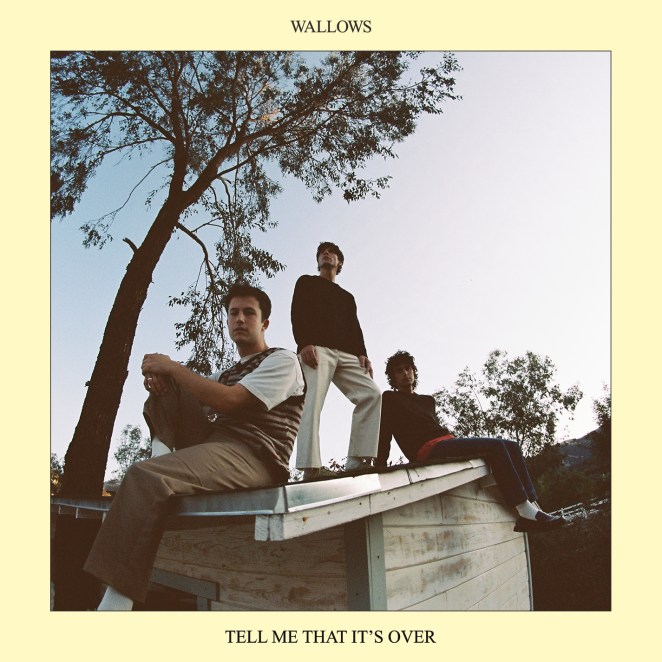Everything switched on for Peach Pit once RAM started playing. Once drummer Mikey Pascuzzi played the 1971 Paul and Linda McCartney album while holed up in a cabin on the island of Gabriola, just off mainland Vancouver, with the rest of the band, Peach Pit’s pilgrimage to start writing their third album From 2 to 3, pushed them down a rabbit hole of rediscovering old Beatles records, George Harrison’s solo material and newer elements that permeated the new album.
Videos by American Songwriter
“‘RAM’ is a great record because it has everything you could ever want,” says Peach Pit singer and songwriter Neil Smith. “It’s got a slow ballad, pop songs, blues songs, and rock songs. We don’t necessarily have that on this record, but it kind of became a goal for us. We wanted to make an album that has a bunch of different stuff on it.”
Revisiting The Beatles in a different way, along with more classic rock and folk of Cat Stevens and Neil Young, From 2 to 3, a follow up to Peach Pit’s 2020 released You and Your Friends, is a collection of songs reflecting personal and external devoted to folkier arrangements fitting in harmonica, cowbell, lap steel, and tambourine, with all hands on board playing instruments.
From 2 to 3 opens on the indie-pop drips of “Up Granville” to the uptempo “Vickie” and the more surf rock notations of “Pepsi on the House.” From 2 to 3 glistens with folk-dipped guitars and more Americana swoops of “Look Out!” through “Give Up Baby Go and “Last Days of Lonesome,” ending on the bare guitar of longing missive “From 2 to 3″—At 2 am / Your emails open on my phone / I’m reading ’em again alone / And caught like that / Just suckered by those thoughts we had / As I get by on you so heavily.
Smith spoke to American Songwriter about the journey to From 2 to 3, flexing the songwriting muscles, and finding his inner McCartney.
_____
American Songwriter: Peach Pit is holed up on a remote island together and out comes a new album. How did everything come together around From 2 to 3 from the time of You and Your Friends (2020)?
Neil Smith: It began pretty soon after we finished recording You and Your Friends. When we first started the band, we didn’t really know anything about how to make an album or what to do, then suddenly you have 10 songs, and then you put out an album. That’s kind of how it worked for the first one. Then from there, we just started touring a ton and throughout that time, I was still writing songs but I didn’t even think about the fact that we also had to make another album. Then we got signed to Columbia, and they said ‘we need another record from you guys.’ Songwriting is a muscle. At least it feels that way for me. If you don’t keep working on songs all the time and keep writing lyrics and melodies, it definitely becomes harder the less you do it. After our last album, I didn’t want to fall into that same thing again, and just kept writing songs—and I never really stopped. When the pandemic hit, and there was nothing else to do, it seemed like a good opportunity to make another record.
AS: Working through a much larger batch of songs, what made you land on these 11?
NS: We recorded songs and it took a while to figure out the track order and what would feel like the best record for us. On our last album, there were a lot of effects on the guitars and vocal effects. On this record, we really wanted to have the guitars sound like guitars and the drums sound like drums and the vocals sound like we were singing and playing together, so these 11 songs were the best version of the record.
AS: All of you were rediscovering Paul McCartney and The Beatles, and obsessively listening to artists like Neil Young. How did this “musical awakening” impact the songs you were writing?
NS: As a group, we’ve definitely changed. We’ve definitely become more collaborative over the years. I used to be pretty protective over the songs that I wrote, kind of precious about them. Typically, I would write a song at home on my acoustic guitar, working on the verses and the choruses, so I had a vision in my head of how I wanted the song to sound. Then I bring it to the band, and maybe that changes. I think more than anything, I’ve realized that my bandmates are great songwriters in their own right, and great musicians, so I’ve learned to trust them more. My own songwriting process has pretty much stayed the same throughout. I’ve also realized that writing songs is very therapeutic for me, even if nobody was going to listen to our music or anything. I always write songs just because it’s one of the only things that really makes me feel better if I have something on my mind, or something is weighing heavy on me, or I’m trying to work through something. Just getting your story down on the page releases something.
AS: Some songs are inspired by people and places on From 2 to 3. What was reflected most from your own life on some of the tracks?
NS: A lot of parts of the album are about my own personal struggles with alcoholism. I quit drinking four years ago, and there’s lots of tunes on our records where I’ve talked about nights when I got really hammered, kind of self-deprecating, or my penchant for blacking out. On this album, I spoke about it more openly from the perspective of somebody who doesn’t drink anymore and looking back on those times. There are definitely some songs on this album that are about a relationship that I was in over the past few years. Sometimes I write a song and I don’t fully understand what I’m singing about when it comes out. Later on, that relationship ended and I listened to the song and it has a new meaning to me all of a sudden.

AS: Why did you land on From 2 to 3 as the title?
NS: It was kind of a double entendre. That [“From 2 to 3”] was the first or second song that I wrote for the record and it happened like every cliche songwriter experience. I woke up in the middle of the night from a horrible dream about an ex-girlfriend. It felt so real, and I was depressed. Then I grabbed my guitar and wrote the song pretty quickly. I wrote it from 2 [a.m.] until 3 a.m., so I thought it would be a good song title. Then I was thinking that it is our third record…
AS: Were there any songs that were unrecognizable and completely transformed from their initial state to the final cut during recording?
NS: “Everything About You” stands out in my mind because it was a weird way that song kind of came about. I was trying to do a sort of a Paul McCartney thing where it’s got a Part A, Part B, Part C and it doesn’t really have a verse or chorus. It’s three distinct parts, almost like three verses or three courses, but they’re all different from each other. Robbie [Lackritz] brought out the best parts of them. The beginning of the song is very melodramatic. It’s very slow and dark sounding. Then the second part has this cool pickup where it goes into more of a mid-tempo folk song. The last is just the chorus of the song, which just repeats over and over again. Robbie got Chris [guitarist Christopher Vanderkooy] to record a really kind of cool guitar part over that, and then we added some mandolin at the end since Chris was inspired by an R.E.M. song, maybe “Losing My Religion,” that had mandolin on it.
“From 2 to 3” also went full circle. It started out as a very sort of solemn tune, just me and my acoustic guitar. And then when we brought it to the band, it turned into a rock song somehow. After we sent Robbie the demo, he said it was all wrong and returned it to its original form.
AS: What kind of songs do you find yourself gravitating towards more now?
NS: I’m always trying to push myself to look outside of myself and not fall into the same patterns that I always seem to fall into. Right now, I recently went through a breakup, so I’m just working on seven breakup tunes.
AS: After so much time with these songs, is there ever a strange sense of detachment from them now that they are out in the world?
NS: Definitely. I think we always feel that way. Once you record the album, and once you’re so into writing it, you get really obsessed with the songs. Then once you’re working on the record, you get really into that. Then once you finish the album it seems like it was a long time ago. I listened to the record so many times every day, thinking about it. At this point, I can’t listen to it ever again. Now it’s for everyone else to listen to and we don’t have to think about it anymore. We’re already thinking about the next album. I want to try to put out as many albums as we can fit into our time as a band together. We’ll play tons of shows this year and hopefully, write a bunch, then maybe in two years, we’ll have another record put out.
Photo: Mackenzie Walker

